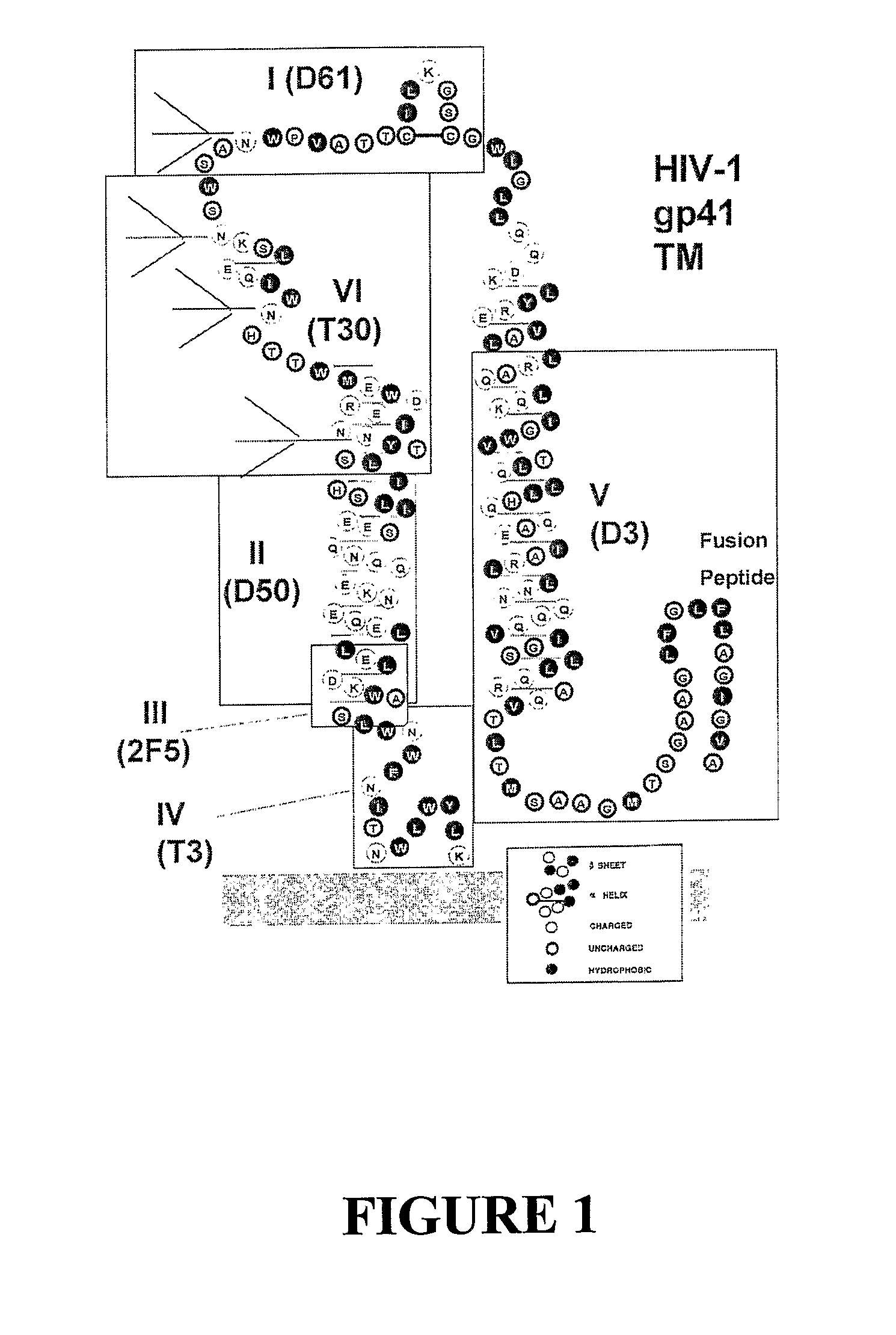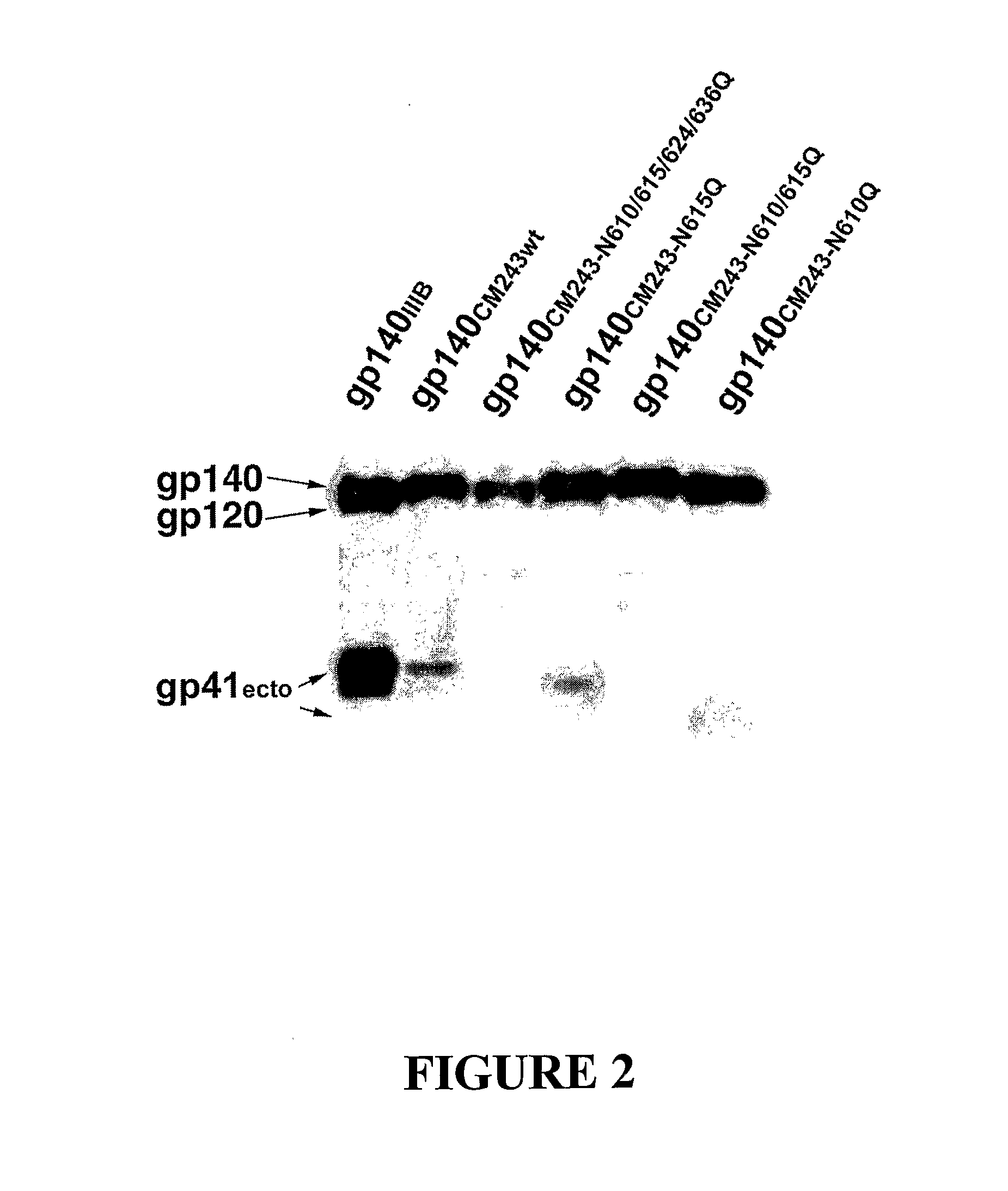Modified HIV-1 Envelope Proteins
a technology of envelope proteins and modified hiv-1, which is applied in the direction of peptide/protein ingredients, viruses, fungi, etc., can solve the problems of insufficient neutralizing activity of divergent strains, inability to elicit sterilization or protective immune responses in infections, and formidable vaccine development tasks
- Summary
- Abstract
- Description
- Claims
- Application Information
AI Technical Summary
Benefits of technology
Problems solved by technology
Method used
Image
Examples
example 1
gp140 Env Constructs
[0085]As a model system to explore the possibility of enhancing the elicitation of antibodies with improved broadly reactive and neutralizing activities, a panel of oligomeric gp140 proteins with deleted N-glycosylation sites in the gp41 ectodomain were designed which were examined as immunogens. Using the HIV-1 CM243, Glade E, R5 primary isolate Env as our model, the highly conserved N-glycosylation sites at positions N610, N615, N624, and N636 (FIG. 1) were removed in various combinations by glutamine substitution for asparagine. Four modified gp140 proteins were selected: (N610Q), (N615Q), (N610 / 615Q) and (N610 / 615 / 624 / 636Q).
[0086]These constructs were used in the vaccinia virus expression system to produce milligram amounts of stable, uncleaved oligomeric gp140 proteins. Briefly, the gp140 proteins were produced by infection of monolayers of BS-C-1 cells (ATCC CCL26) in roller bottles (850 cm2) with the appropriate recombinant vaccinia viruses at a multiplici...
example 2
Neutralization Assays
[0089]The ability of immune sera to inhibit pseudotyped virus infection of HOS-CD4-CCR5 cells, was assayed as described previously (Park et al. (2000) J. Virol. 74, 4183-4191). This assay system has demonstrated that the results obtained are very similar to those obtained using conventional virus neutralization assays of the same primary or laboratory adapted HIV-1 strains (Zhang et al. (1999) J. Virol. 73, 5225-5230). The pseudotyped virus assay is widely employed, rapid, quantitative, and cost-effective. To prepare viruses for these assays, 293T cells were cotransfected with the plasmids pNL4-3.luc.E-R- and pSV7d-HIV-lenv (Deng et al. (1996) Nature 381, 661-666). They included the R2 and SF162 envelope genes and other envelope genes described above. HOS-CD4-CCR5 cell cultures were prepared at approximately 60 to 80% confluency in 96-well opaque walled tissue culture trays, then pretreated with medium containing polybrene (8 μg / ml) for thirty minutes. Serial tw...
example 3
gp140 Env Antibodies
[0091]The sera from the rabbits immunized with the gp140CM243(N610Q) also neutralize strains of subtype C, B, and D, as shown in FIG. 6. This cross-reactivity is highly remarkable since sera from donors infected with subtype E strains do not generally neutralize strains of other subtypes at all, particularly subtype B strains. Moreover, the cross-reactivity pattern is much different than we see in response to R2 envelope (a specific HIV-1 Glade B env isolate known to induce cross-reactive neutralizing antibody responses (Dong et al. (2003) J. Virol. 77, 3119-306; Quinnan (1999) AIDS Res Hum Retroviruses 15, 561-70) in which case the sera neutralized subtype A, B, C, and F strains, but not subtype D or E strains. It is also important to recognize that Env-based vaccine strategies to elicit neutralizing antibodies to Glade E viruses have thus far been unsuccessful (Kim et al. (2003) AIDS Res. Hum. Retroviruses 19, 807-816).
[0092]In related experiments the CM243 and...
PUM
| Property | Measurement | Unit |
|---|---|---|
| Fraction | aaaaa | aaaaa |
| Fraction | aaaaa | aaaaa |
| Fraction | aaaaa | aaaaa |
Abstract
Description
Claims
Application Information
 Login to View More
Login to View More - R&D
- Intellectual Property
- Life Sciences
- Materials
- Tech Scout
- Unparalleled Data Quality
- Higher Quality Content
- 60% Fewer Hallucinations
Browse by: Latest US Patents, China's latest patents, Technical Efficacy Thesaurus, Application Domain, Technology Topic, Popular Technical Reports.
© 2025 PatSnap. All rights reserved.Legal|Privacy policy|Modern Slavery Act Transparency Statement|Sitemap|About US| Contact US: help@patsnap.com



